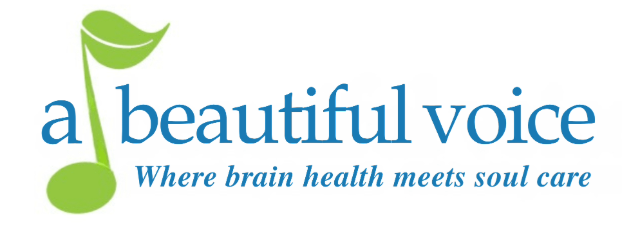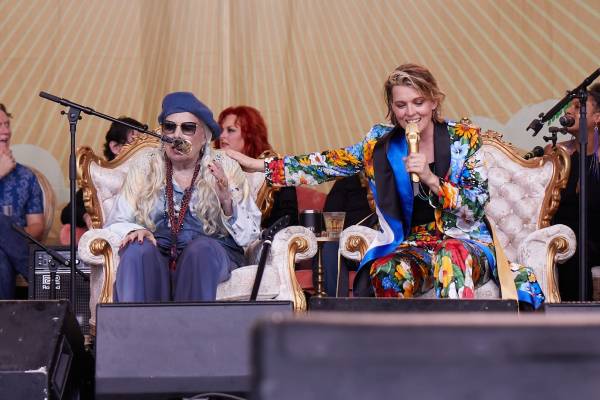Brandi Carlile & Joni Mitchell at the Newport Folk Festival in 2022 – WFUV Public Radio/CC BY-NC-SA 2.0
With so much driving us apart, music offers opportunities for solace and bridge-building.
Intergenerational duets are having a moment. Paul Simon, 83, and Sabrina Carpenter, 58 years younger, cold-opened Saturday Night Live’s 50th Anniversary show performing “Homeward Bound” together. We saw Dick Van Dyke and Chris Martin, 52 years apart, sing and dance in a recent video for the Coldplay song “All My Love.” Luke Combs covered Tracey Chapman’s “Fast Car,” recorded the year before Combs, 34, was born. At the 66th Grammy ceremony, they performed together to wild acclaim. There’s more: Brandi Carlile and Joni Mitchell, Dolly Parton and Beyonce, Elton John and Dua Lipa, Kendrick Lamar and Run DMC. Not to mention Tony Bennett and Lady Gaga.
Popular music seems an odd stage for a revolution in good generational vibes. After all, the business of music is skewed toward selling the sex-appeal of edgy young artists.
So why is music telling this story of cross-generational collaboration and affection? Why now, when so many media headlines tout the opposite, a war between generations, at each other’s throats over power, jobs, housing, entitlements, climate, and more? Finally, how can we move beyond tunes that reverberate to actual reconciliation across divides?
Music transcending division
Examples abound. One of the most stirring scenes in Questlove’s documentary about the 1969 Harlem Music Festival, Summer of Soul, features an elder Mahalia Jackson together with an up-and-coming Mavis Staples, singing the gospel standard “Precious Lord, Take My Hand.” The Torch—an acclaimed 2019 documentary—tells the story of 80-something blues legend Buddy Guy’s collaboration with Quinn Sullivan, a 20-something guitar phenomenon from the Chicago suburbs.
Perhaps no genre has embraced the intergenerational ethos more fully than jazz. Take the bond between 28-year-old Grammy-winning pianist Luther Allison and his 70- year-old mentor Donald Brown of the Jazz Messengers. Brown and other older jazz greats were the inspiration for Allison’s breakout album, “I Owe It All to You.” In an interview, he explained that the album was an exercise in gratitude toward, and collaboration with, all “those who have invested in me and supported my musical development.”
Beyond tradition, there’s pleasure; these collaborations just sound good. And there’s a reason, one that extends beyond music. Harvard professor Arthur Brooks argues that older and younger people possess complementary skills—what he calls fluid (young people) and crystallized (older people) intelligence. These musical collaborations illustrate a variation. Combining the confident power of younger artists and the wizened vulnerability of older ones produces something distinctive and different from same-age combinations.
One vivid example is the late Kris Kristofferson’s duet with Brandi Carlile at Joni Mitchell’s 75th birthday party in 2018. They came together to sing Mitchell’s “A Case of You.” In between swapping verses and joining in harmonies, Carlile helps an occasionally faltering Kristopherson remember the song’s lyrics. The result is magical. It’s one thing to tell about the unique value of older and younger people coming together, it’s another to show what that looks, and sounds, like.
Musical healing across generations
Music may be the perfect stage for generational collaboration because we’re wired to respond positively to it. Research shows that one of the most important things grandmothers have done through time is sing to young children.
Neuroscientists now believe that music is a critical ingredient in sustaining health. In his recent book, I Heard There Was a Secret Chord, scholar Daniel Levitin describes music as a kind of medicine treating, in one way or another, a range of afflictions including dementia and cognitive decline. Cellist Yo Yo Ma goes further, arguing that music is a kind of social medicine, as well, connecting and healing generations.
The increasing popularity of intergenerational duets couldn’t come at a better time. For all the attention to the aging of American society, arguably the most important demographic development today is age diversity.
Research from Stanford shows that we now have approximately the same number of people alive at every age from birth to 75. A quarter of the population is under 20, and a quarter is over 60. In other words, there are a lot of Paul Simons and Sabrina Carpenters, in roughly equal proportion.
Fortunately, innovative musical initiatives in communities across the country are illuminating ways to make this idea real in the lives of the not-so-famous—and in areas of urgent national importance.
Mind & Melody addresses the dementia crisis by connecting young musicians and older ones in memory care settings. “Music serves as a lightbulb switch in the brain,” said the program’s director Orianna Gutierrez, helping connect participants “with themselves and the world around them.”
Now operating in 36 cities in Florida, New York, and New Mexico, the program connects people for music sessions virtually and in person. That’s how Mala—an Auschwitz survivor born in Poland and living in Miami Beach—met Amelia, 58 years her junior. Turns out Amelia, a musician living in Tallahassee, is the daughter of a Holocaust survivor who rarely spoke of his experiences.
Mala introduced Amelia to Jewish songs and prayers, unlocking a heritage Amelia had never fully embraced and giving her a newfound appreciation for her identity. Through their shared songs in Yiddish and Hebrew, the two women forged a deep, emotional connection.
Proximity, purpose, and partnership
At Arizona State University, Mirabella is a high-rise that houses elders on campus, helping to bring generations together while creating a new model for senior housing. The arrangement makes it possible for music-loving older folks and grad students to live, and play, side by side. Grad students like Michelle Kim, a Canadian pianist who immigrated from South Korea as a child, and elders like Emily Zeigler, a white, retired Wall Street lawyer from New York.
Fifty years apart in age, both had, with great reluctance, given up the flute in their youth—Kim to focus on piano, Ziegler on academics. When they discovered their shared history, the two vowed to rectify it. Soon they were playing flute duets not only with and for each other, but in performances at the university and in the surrounding community. And they forged a friendship, one bridging multiple dimensions.
In Los Angeles, the Eisner Intergenerational Orchestra brings older and younger musicians together to play—and also to cross barriers of race and culture while healing one of LA’s most ravaged communities. It’s proved life-saving for at least one young musician. After severe bullying from high school classmates, violist Isabella Mier was suicidal and losing hope when she discovered the orchestra.
“Why don’t I just go play for one of my last times?” she asked herself. “And I went, and I just felt so at home, like I had a new family,” she explained during a recent webinar. “It really gave me a reason to keep going.” Nine years later, she’s the principal violist in the Orchestra.
Those stories reveal a formula for making the most of our multigenerational future, one characterized more by harmony than discord.
In each of these examples, we see the intersection of proximity, older and younger in each other’s company; purpose, the shared commitment to something—in this case, music; and partnership, not just being together, not just sharing an interest, but doing something together. That collaboration can be the crucible for understanding, appreciation, and accomplishment in—and beyond—music.
The myriad potential benefits of intergenerational musical collaboration include mental and physical wellness, social healing across difference, and a healthy dose of joy. But perhaps the most fundamental gift is a sense of the wholeness of life, as past, present, and future come together in ways that enrich all three and create some great music in the process.
This article originally appeared on Greater Good, the online magazine of the Greater Good Science Center at UC Berkeley. To promote a kinder and more compassionate society, permission is granted to republish articles for free, online or in print under Creative Commons license.
Authors
____________
Posted by: Susan Troyer, Website author and curator

Member:




Leave A Comment